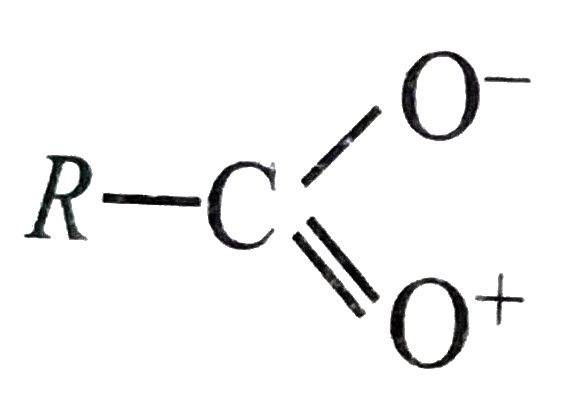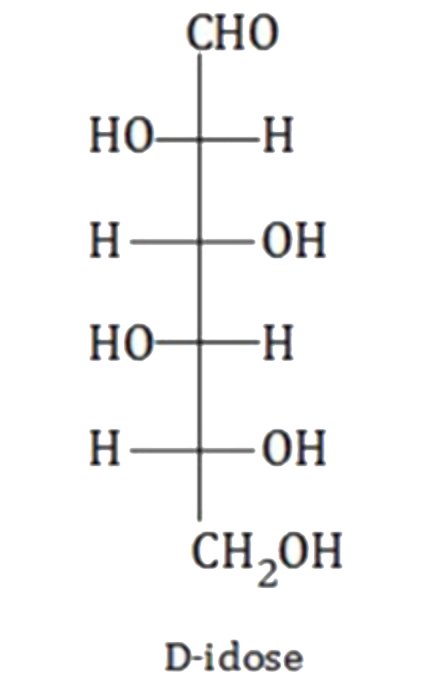The correct structure representation of carboxylate ion is




The correct Answer is:B
To determine the correct structure representation of a carboxylate ion, we can follow these steps:
Step 1: Understand the Carboxylate Ion
A carboxylate ion is derived from a carboxylic acid when it donates a proton (H⁺). The general structure of a carboxylic acid is R-COOH, where R is a hydrocarbon group. When the acidic hydrogen is removed, the structure becomes R-COO⁻.
Step 2: Draw the Basic Structure
Start by drawing the basic structure of the carboxylate ion. It consists of a carbon atom (C) double-bonded to one oxygen atom (O) and single-bonded to another oxygen atom (O) that carries a negative charge. The structure can be represented as follows:
O∣∣R−C−O⁻
Step 3: Consider Resonance
The carboxylate ion can exhibit resonance. This means that the negative charge can be delocalized between the two oxygen atoms. To represent this, we can draw two resonance structures:
1. In the first structure, the carbon is double-bonded to one oxygen and single-bonded to the other oxygen with a negative charge.
2. In the second structure, the double bond shifts to the other oxygen, and the first oxygen now carries the negative charge.
The resonance structures can be depicted as:
1. Structure 1:
O∣∣R−C−O⁻
2. Structure 2:
O⁻∣R−C=O
Step 4: Draw the Resonance Hybrid
The actual structure of the carboxylate ion is a resonance hybrid of these two structures. In the hybrid, both C=O bonds are represented as having partial double bond character, and the negative charge is equally distributed between the two oxygen atoms. This can be represented as:
O/R−C−O
Where the double bonds are partial, indicating resonance.
Step 5: Identify the Correct Answer
From the options provided, identify which structure corresponds to the resonance hybrid we just drew. The correct representation of the carboxylate ion will show the partial double bond character and the negative charge distributed between the two oxygen atoms.
Final Answer
The correct structure representation of the carboxylate ion is option B, which shows the resonance hybrid with partial double bond character and the negative charge.
---
A carboxylate ion is derived from a carboxylic acid when it donates a proton (H⁺). The general structure of a carboxylic acid is R-COOH, where R is a hydrocarbon group. When the acidic hydrogen is removed, the structure becomes R-COO⁻.
Start by drawing the basic structure of the carboxylate ion. It consists of a carbon atom (C) double-bonded to one oxygen atom (O) and single-bonded to another oxygen atom (O) that carries a negative charge. The structure can be represented as follows:
O∣∣R−C−O⁻
The carboxylate ion can exhibit resonance. This means that the negative charge can be delocalized between the two oxygen atoms. To represent this, we can draw two resonance structures:
1. In the first structure, the carbon is double-bonded to one oxygen and single-bonded to the other oxygen with a negative charge.
2. In the second structure, the double bond shifts to the other oxygen, and the first oxygen now carries the negative charge.
1. Structure 1:
O∣∣R−C−O⁻
2. Structure 2:
O⁻∣R−C=O
The actual structure of the carboxylate ion is a resonance hybrid of these two structures. In the hybrid, both C=O bonds are represented as having partial double bond character, and the negative charge is equally distributed between the two oxygen atoms. This can be represented as:
O/R−C−O
Where the double bonds are partial, indicating resonance.
From the options provided, identify which structure corresponds to the resonance hybrid we just drew. The correct representation of the carboxylate ion will show the partial double bond character and the negative charge distributed between the two oxygen atoms.
The correct structure representation of the carboxylate ion is option B, which shows the resonance hybrid with partial double bond character and the negative charge.
Topper's Solved these Questions
- BOOK - NCERT FINGERTPS ENGLISHCHAPTER - ALDEHYDES, KETONES AND CARBOXYLIC ACIDSEXERCISE - MCQs( METHODS OF PREPARATION OF CARBOXYLIC ACIDS )7videos
ALDEHYDES, KETONES AND CARBOXYLIC ACIDS
- BOOK - NCERT FINGERTPS ENGLISHCHAPTER - ALDEHYDES, KETONES AND CARBOXYLIC ACIDSEXERCISE - MCQs( PHYSICAL PROPERTIES )2videos
ALDEHYDES, KETONES AND CARBOXYLIC ACIDS
- BOOK - NCERT FINGERTPS ENGLISHCHAPTER - ALDEHYDES, KETONES AND CARBOXYLIC ACIDSEXERCISE - MCQs( CHEMICAL REACTIONS )50videos
ALDEHYDES, KETONES AND CARBOXYLIC ACIDS
- BOOK - NCERT FINGERTPS ENGLISHCHAPTER - ALCOHOLS,PHENOLS AND ETHERSEXERCISE - Assertion And Reason14videos
ALCOHOLS,PHENOLS AND ETHERS
- BOOK - NCERT FINGERTPS ENGLISHCHAPTER - AMINES EXERCISE - ASSERTION & REASON CORNER14videos
AMINES
Similar Questions
Consider the following structures and calculate value of (P2−Q2)
Where P=total number of correct structure representation.
Q=Total number of incorrect structure representation.
 View Solution
View SolutionThe correct representation of binomial nomenclature is
View SolutionThe correct representation of Charle's law is given in
View SolutionThe correct graph representation of potential along the branch PQRS is
 View Solution
View SolutionWhich of the following is the correct representation of organisation levels in beings ?
View SolutionOn a logarithmic scale the correct representation of species area relationship is represented by the equation
View SolutionAccording to recent views which is the correct representation of hydrated proton in aqueous solution ?
View SolutionThe correct representation of the pyramid is ,
View Solutionwhich is the correct representation of cardiac cycle.
 View Solution
View SolutionWhich of the following structures is the correct Haworth representation of D - aldose?
 View Solution
View Solution

